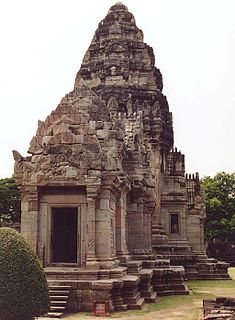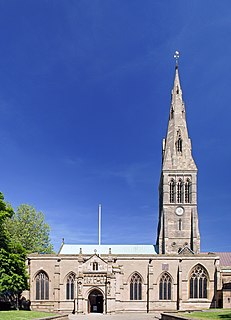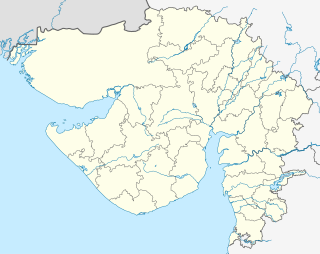Latina is the feminine form of the term Latino.

The architecture of India is rooted in its history, culture and religion. Among a number of architectural styles and traditions, the contrasting Hindu temple architecture and Indo-Islamic architecture are the best known historical styles. Both of these, but especially the former, have a number of regional styles within them.

The Kamakhya Temple also known as Kamrup-Kamakhya temple, Kamakhya Devalaya, is a Hindu temple dedicated to the mother goddess Kamakhya. It is one of the oldest of the 51 Shakti Pithas. Situated on the Nilachal Hill in western part of Guwahati city in Assam, India, it is the main temple in a complex of individual temples dedicated to the ten Mahavidyas of Saktism : Kali, Tara, Sodashi, Bhuvaneshwari, Bhairavi, Chhinnamasta, Dhumavati, Bagalamukhi, Matangi and Kamalatmika. Among these, Tripurasundari, Matangi and Kamala reside inside the main temple whereas the other seven reside in individual temples. It is an important pilgrimage destination for Hindus and especially for Tantric worshipers.

A prang is a tall tower-like spire, usually richly carved. They were a common shrine element of Hindu and Buddhist architecture in the Khmer Empire. They were later adapted by Buddhist builders in Thailand, especially during the Ayutthaya Kingdom (1350–1767) and Rattanakosin Kingdom (1782-1932). In Thailand it appears only with the most important Buddhist temples.

Francesco Antonio Picchiatti was an Italian architect of the Baroque period active in Naples. He is also called Picchetto. He was son of Bartolommeo Picchiatti, who also served as an architect in Naples.

Vimana is the structure over the garbhagriha or inner sanctum in the Hindu temples of South India and Odisha in East India. In typical temples of Odisha using the Kalinga style of architecture, the vimana is the tallest structure of the temple, as it is in the shikhara towers of temples in West and North India. By contrast, in large South Indian temples, it is typically smaller than the great gatehouses or gopuram, which are the most immediately striking architectural elements in a temple complex. A vimana is usually shaped as a pyramid, consisting of several stories or tala. Vimana are divided in two groups: jati vimanas that have up to four tala and mukhya vimana that have five tala and more.

A broach spire is a type of tall pyramidal or conical structure (spire) which usually sits atop a tower or turret of a church. It starts on a square base and is carried up to a tapering octagonal spire by means of triangular faces.

Bhumija is a variety of northern Indian shikhara that is particularly popular in temples of western India, northern Deccan and the Malwa regions in India. It comprises a central Latina projection, tapering towards the top on all four faces. The quadrants so formed are decorated with miniature spires, in horizontal and vertical rows, all the way to the top.

Yana is a village located in forests of the Kumta, Uttara Kannada district of Karnataka, India which is known for the unusual karst rock formations. It is located in the Sahyadri mountain range of the Western Ghats, about 60 kilometres (37 mi) from Karwar port, 40 kilometres (25 mi) from Sirsi, and 31 kilometres (19 mi) from Kumta. Yana is one of the wettest villages in the world and it is cleanest village in Karnataka and second cleanest village in India. The two unique rock outcrops near the village are a tourist attraction and easily approachable by a small trek through 0.5 kilometres (0.31 mi) of thick forests from the nearest road head.
Lady Ann Juliet Dorothea Maud Tadgell, previously Marchioness of Bristol, is a British heiress, race horse breeder, and landowner. She consistently appears on the Sunday Times Rich List with an estimated net worth of £45 million, based on family assets she inherited in 1948.

The Vigneshwara Temple or Vighnahar Ganapati Temple of Ozar is a Hindu temple dedicated to Ganesha, the elephant-headed god of wisdom. The temple is one of the Ashtavinayaka, the eight revered shrines of Ganesha in Maharashtra, India. The Ganesha form worshipped here is called Vigneshwara or Vignahar and is associated with the legend of Ganesha defeating Vignasura, the demon of obstacles.

A deula is an element in a Hindu temple in the local style of Odisha temple in Eastern India.

The Gop temple is a Sun temple located at Zinavari village in Jamjodhpur Taluka of Jamnagar district, Gujarat, India. The Hindu temple is dated to the 6th century and is one of the earliest surviving stone temples in Gujarat. The original temple had a square plan, a mandapa and covered circumambulation passage which are lost, and a pyramidal masonry roof which is ruined but whose partial remains have survived. The temple has a height of 23 feet (7.0 m) which includes a small tower. The roof of the tower is decorated with arch-like gavaksha window shapes below an amalaka cogged wheel-shaped crown.

The Shiva temple is located at Bavka in Dahod district, Gujarat, India. It is located on a knoll near Hirlav lake between Bavka and Chandavada village, 14 km from Dahod.

Housham Tye is a hamlet in the civil parish of Matching, and the Epping Forest district of Essex, England.

Magderu is an 8th-century temple of Maitraka period located near Dhrasanvel village in Okhamandal Taluka of Devbhoomi Dwarka district, Gujarat, India. The temple is located three miles northeast of Dwarka.

The Kalika Mata Temple is located at New Dhrewad in Devbhoomi Dwarka district, Gujarat, India.



















